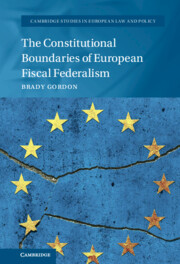Book contents
- The Constitutional Boundaries of European Fiscal Federalism
- Cambridge Studies in European Law and Policy
- The Constitutional Boundaries of European Fiscal Federalism
- Copyright page
- Basic Table of Contents
- Detailed Table of Contents
- Figures
- Acknowledgements
- Table of Cases
- Table of Legislation, Treaties and Conventions
- Abbreviations
- Part I
- Part II
- 5 The Emergent Centralized Architecture of European Fiscal Federalism
- 6 The Constitutional Boundaries of Economic and Monetary Union under EU Law
- 7 The Constitutional Boundaries of Member State Fiscal Sovereignty
- 8 Principles of Fiscal Federalism for the European Union
- Conclusion
- Proposed Directions for Future Research and Reform
- Bibliography
- Index
5 - The Emergent Centralized Architecture of European Fiscal Federalism
from Part II
Published online by Cambridge University Press: 07 April 2022
- The Constitutional Boundaries of European Fiscal Federalism
- Cambridge Studies in European Law and Policy
- The Constitutional Boundaries of European Fiscal Federalism
- Copyright page
- Basic Table of Contents
- Detailed Table of Contents
- Figures
- Acknowledgements
- Table of Cases
- Table of Legislation, Treaties and Conventions
- Abbreviations
- Part I
- Part II
- 5 The Emergent Centralized Architecture of European Fiscal Federalism
- 6 The Constitutional Boundaries of Economic and Monetary Union under EU Law
- 7 The Constitutional Boundaries of Member State Fiscal Sovereignty
- 8 Principles of Fiscal Federalism for the European Union
- Conclusion
- Proposed Directions for Future Research and Reform
- Bibliography
- Index
Summary
Chapter 5 opens for Part II of the book with the task of taxonomy, classifying the emergent post-crisis EU fiscal architecture from the perspective of fiscal federalism theory in order to determine what it demands from the EU legal order to ‘work’. Chapter 5 finds that, from the perspective of fiscal federalism theory, the EU has sunk the cornerstones of a highly centralized model of ‘proto-fiscal union’ that is far more apt to unitary states than any of the other federations touched upon in this book. At its core, the new model supplants a legal pillar of fiscal sovereignty and market discipline (an entrenched ‘no-bailout’ law) with a legal feature of unitary states: centralized financial assistance and legal governance of fiscal policy. Chapter 5 evaluates the demands this places on the European legal order, and provides directions for the remainder of the analysis of Part II.
Keywords
- Type
- Chapter
- Information
- The Constitutional Boundaries of European Fiscal Federalism , pp. 203 - 215Publisher: Cambridge University PressPrint publication year: 2022

